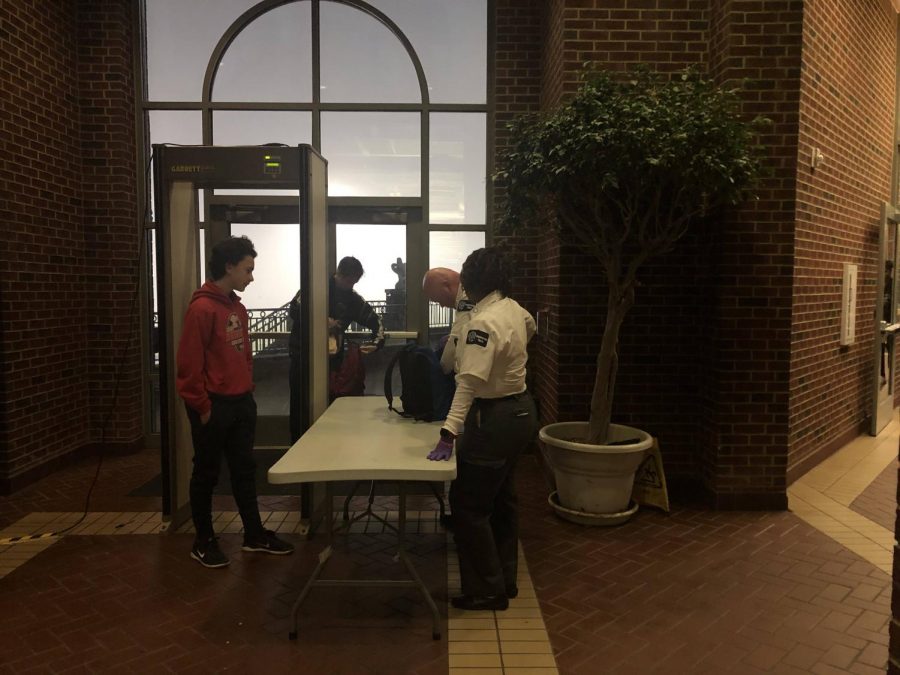More than just a lockdown drill
Every morning, students must clear metal detectors and have their bags searched when entering the school. Metal detectors are part of a new security protocol added this school year.
Suddenly, my entire class is still, fingers frozen to our keyboards. It takes some of us longer than others to process what is happening: the deafening siren means a lockdown. We haven’t heard about a scheduled drill. It could be real this time.
When the lockdown alarm went off on Dec. 7, I had no idea that it was a drill.
The substitute teacher offered us no instruction. Some level headed students took charge, turning off the computer monitors and the classroom lights. Someone closed the door, but I wasn’t sure if it was locked. We hid the best we could, well aware that there was nothing to cover the windows on the computer lab’s door.
I wanted to believe that it wasn’t real, but that didn’t stop the panic rising in my throat.
The live updates began over the announcements. The suspect was just a few flights of stairs below us. The girl next to me held onto my arm.
I heard whispers that it was real. Others had heard that it might be a drill. It was always a drill. But nobody had told us that it was. This was the only drill I can remember in which there was no announcement beforehand. That was the loudest thought in my mind in the long silences between each announcement. Adrenaline produced a terrifying image.
As the intruder reached the other end of the building people began to whisper “should we leave?”
Our substitute teacher was silent.
“Should we call 911?” someone asked.
We did neither. We waited, as if someone would tell us where to go, or blockade the door, or tell us it that it was just a drill.
In those moments I felt sure that we were unprepared for the situation. That if it was real, we were in danger, and it was too late.
The imaginary suspect was finally caught and the drill was called off, and a few of us laughed with relief. And then my laughing was cut off by a sob. Tears pooled in my eyes and I realized just how scared I had been.
I know my experience was not the experience of everyone who was in that room. As I tried to calm down, many of my peers returned to their work, seemingly unphased. But my hands were still shaking as I texted my friends, trying to make sense of what had just happened.
I imagined at first that it had been some kind of surprise drill, that everyone had been just as unsure. However, as I learned in the next hours, it was only a surprise to us. Although there was no broadcast announcement, teachers had been made aware of the drill and informed their students.
In my next class, not a single person seemed as rattled as I felt. Some had even continued taking a math test right through it. However, even students who weren’t in my class agreed that there was something off about the drill.
There is a precedent that armed intruder simulations will be announced to the entire school a few minutes before they begin. A deviation from this procedure created the opportunity for confusion and panic. Whether the substitute teacher knew that it was a drill or not, the situation could have been avoided if there was an announcement.
This time, only a handful of students shared my experience, but this is an issue that WHHS and CPS must be aware of and take seriously. Had the confusion been more widespread across the building, there may have been greater consequences.
On Dec. 7, just a few hours after our drill, there was an unannounced drill at Lake Brantley High School in Altamonte Springs, Florida. In fact, students and staff were instructed that it was not a drill at all.
One staff member, believing there was a real threat, activated an alert system that fed the panic. The false threat spread to parents and nearby schools. Students and teachers barricaded rooms and ran from the school in a panic. Some students reported having asthma attacks and other reactions during the drill, which administrators attempted to call off after 24 minutes, resulting in more panic.
The event left many members of the school community deeply unsettled. It raises the question, what price should we be willing to pay to conduct these drills?
To be clear, the fact that I was not aware of our lockdown drill was the result of some mistake in the line of communication. The drill was never meant to be unannounced. However, I fear the consequences if WHHS ever does attempt what Lake Brantley High School did.
What I saw and felt during those few turbulent minutes have led me to feel less safe at school than I ever have before. No drill ever prepared me for the adrenaline response that I had. No drill prepared me to hear my classmates debating whether the situation was real or not.
I think back to our most recent lockdown drill, in which half of my class ran from the building and half of us stayed in the room when the intruder turned back towards our room. Even now, I’m not sure what the right choice would have been. The situation was never revisited. It should be. And so should the situation that my class experienced last week.
If we don’t take the time to learn anything from lockdown drills, they don’t make us any safer.
With issues like lockdown simulations, there isn’t an easy answer. There is a delicate balance between fixating too much on a grim possibility and giving it less attention than it requires. But there must be a willingness to observe and improve, or at least question, the current method.
Lockdown drills are necessary, but schools must address their faults and their impact on students. When you ask students to participate in a drill, you are asking them to do more than follow directions and sit quietly. You are asking them to imagine that their greatest fear is walking the halls of their school. That should never be taken lightly.
We need to change the way we think about drills. In the short term, that means revisiting and learning from errors during drills. On a greater scale, coordinators should seek to understand and acknowledge the psychological impact of drills. The process can be improved, and that improvement should start with students.
Students have the most valuable information about lockdowns to give. Administrators have the resources to implement an instant online feedback survey after the next drill or create focus groups of students to improve the system.
Too often, students and staff alike think of lockdown drills as accepted inconveniences. We don’t stop to observe and question them. My experience showed me that there is more to be said about school safety practices, and that students must be the ones to say it.
Your donation will support the student journalists of Walnut Hills High School. Your contribution will allow us to purchase equipment, cover our annual website hosting, printing costs and offset competition and conferences fees for students.










![Freshman choir students practice in class. “[The class] is almost like an army working together,” Anthony Nims, choir director, said.](https://whhscbox.com/wp-content/uploads/2025/10/freshman-choir.png)
![New theater teacher Mr. Mitchell leads his Stagecraft students through hands-on set-building techniques. “For me, [teaching] comes from the joy of learning, which is why I wanted to be in an educational setting.”](https://whhscbox.com/wp-content/uploads/2025/10/IMG_3248-451x600.jpeg)


